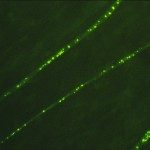Lien vers Pubmed [PMID] – 33264290
Lien DOI – 10.1371/journal.pntd.0008878
PLoS Negl Trop Dis 2020 Dec; 14(12): e0008878
Mycobacterium ulcerans, the causative agent of Buruli ulcer (BU) disease, is unique amongst human pathogens in its capacity to produce a lipid toxin called mycolactone. While previous studies have demonstrated that bacterially-released mycolactone diffuses beyond infection foci, the spatiotemporal distribution of mycolactone remained largely unknown. Here, we used the zebrafish model to provide the first global kinetic analysis of mycolactone’s diffusion in vivo, and multicellular co-culture systems to address the critical question of the toxin’s access to the brain. Zebrafish larvae were injected with a fluorescent-derivative of mycolactone to visualize the in vivo diffusion of the toxin from the peripheral circulation. A rapid, body-wide distribution of mycolactone was observed, with selective accumulation in tissues near the injection site and brain, together with an important excretion through the gastro-intestinal tract. Our conclusion that mycolactone reached the central nervous system was reinforced by an in cellulo model of human blood brain barrier and a mouse model of M. ulcerans-infection. Here we show that mycolactone has a broad but heterogenous profile of distribution in vivo. Our investigations in vitro and in vivo support the view that a fraction of bacterially-produced mycolactone gains access to the central nervous system. The relative persistence of mycolactone in the bloodstream suggests that assays of circulating mycolactone are relevant for BU disease monitoring and treatment optimization.











